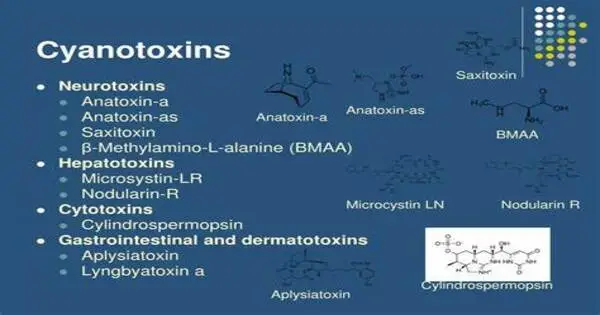Cyanotoxins are poisons produced by cyanobacteria (sometimes called blue-green algae). These poisons may be detrimental to humans, animals, and aquatic environments. These are frequently found in freshwater bodies including lakes, ponds, and rivers, as well as marine habitats. These can be found practically anywhere, but they are most abundant in lakes and the ocean, where they proliferate exponentially to form blooms in high phosphorus circumstances.
Blooming cyanobacteria can create cyanotoxins in high enough concentrations to harm and kill animals and people. Cyanotoxins can also build in other animals, such as fish and shellfish, resulting in poisonings like shellfish poisoning. Cyanotoxins are among the most powerful natural poisons known. They contain strong neurotoxins, hepatotoxins, cytotoxins, and endotoxins. Despite their similar names, they are not related to cyanides. Cyanobacteria exposure can cause gastroenteritis, hay fever, and pruritic skin rashes.
There are several types of cyanotoxins, including microcystins, anatoxins, cylindrospermopsin, saxitoxins, and others. Each type of cyanotoxin has its own specific effects on organisms. For example, microcystins primarily affect the liver and can cause symptoms ranging from nausea and vomiting to liver damage and even liver cancer in severe cases. Anatoxins target the nervous system and can cause symptoms such as muscle twitching, convulsions, and respiratory paralysis.
Exposure to the cyanobacteria neurotoxic BMAA may be a risk factor for neurological disorders such amyotrophic lateral sclerosis (ALS), Parkinson’s disease, and Alzheimer’s. There is also a focus on the military potential of biological neurotoxins like cyanotoxins, which “have gained increasing significance as potential candidates for weaponization.”
Ingestion of polluted water, inhalation of aerosolized toxins (such as during leisure activities like swimming), or consumption of contaminated food or drinking water can all lead to cyanotoxin exposure. Because of the possible health dangers connected with cyanotoxins, monitoring and managing cyanobacterial blooms in water bodies is critical for public health and environmental protection.
















